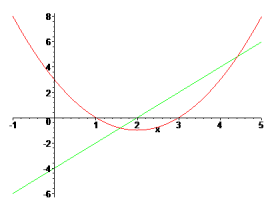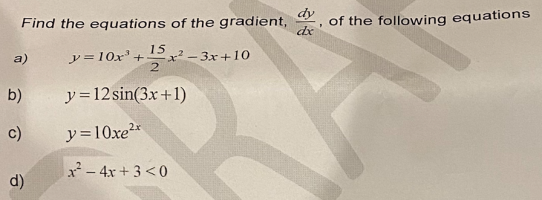method for finding the derivatives of linear inequalities
eg: x^2 - 4x + 3 < 0
Hi Nick. That's not a linear polynomial (it's quadratic), and I'm not sure what you mean by talking about derivatives of inequalities. We take derivatives of functions, not of equations or inequalities.
I'll post some basic statements below, yet I suspect that either you or I have misinterpreted something. Please reply by clarifying what you're trying to do or understand.

I don't think the answer is simply: 2x - 4 < 0
Okay, but what is the question?
If the exercise asks you to solve the
quadratic inequality, then the solution is a set of x-values. Specifically, it's the set of all inputs that cause the quadratic function to output a negative value.
The leading coefficient of the function x^2 – 4x + 3 is positive, so we know the parabolic graph opens upward.
The discriminant (b^2–4ac) of the function is 4, so we know the graph has two x-intercepts.
Therefore, we know the graph lies below y=0 between the x-intercepts, so the solution to the quadratic inequality is the set of all x-values strictly inbetween those two roots.
The quadratic polynomial's first derivative is the linear function 2x–4.
2x – 4 < 0
The solution to the
linear inequality is also a set of x-values. That set contains all values of x that cause the function 2x–4 to be negative.
… if a function is increasing, you cannot expect that its derivative will increase too.
That is correct, but we do expect that the derivative will be positive anywhere the function is increasing.
In summary, the first derivative of a function is new function that outputs the slope (i.e., the rate of change) of the original function. Let's name the quadratic function f. By convention, the name of the first derivative function is f' (f-prime).
f(x) = x^2 – 4x + 3
f'(x) = 2x – 4
What is the slope of the parabolic graph when x is -1? That slope is f'(-1). In other words, the slope is -6.
What is function f's rate of change when x=2? That number is f'(2)=0.
What's the slope at x=7/2? It's f'(7/2) which is 3.
Here is a graph of f(x) and f'(x) for x-values from -1 to 5. Again, function f' gives the slope of function f, at each x in the domain.



